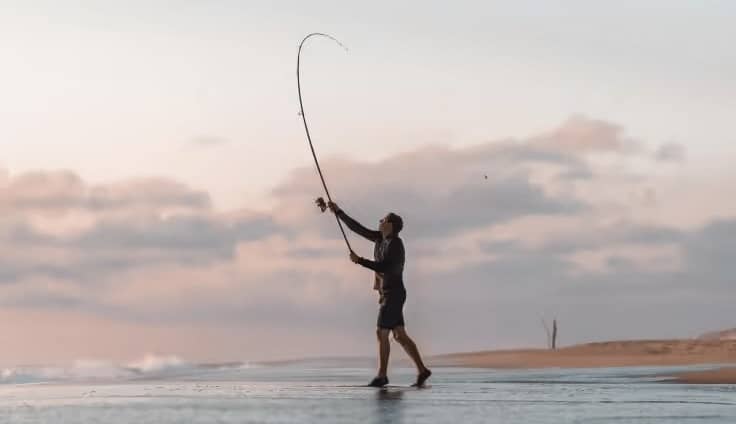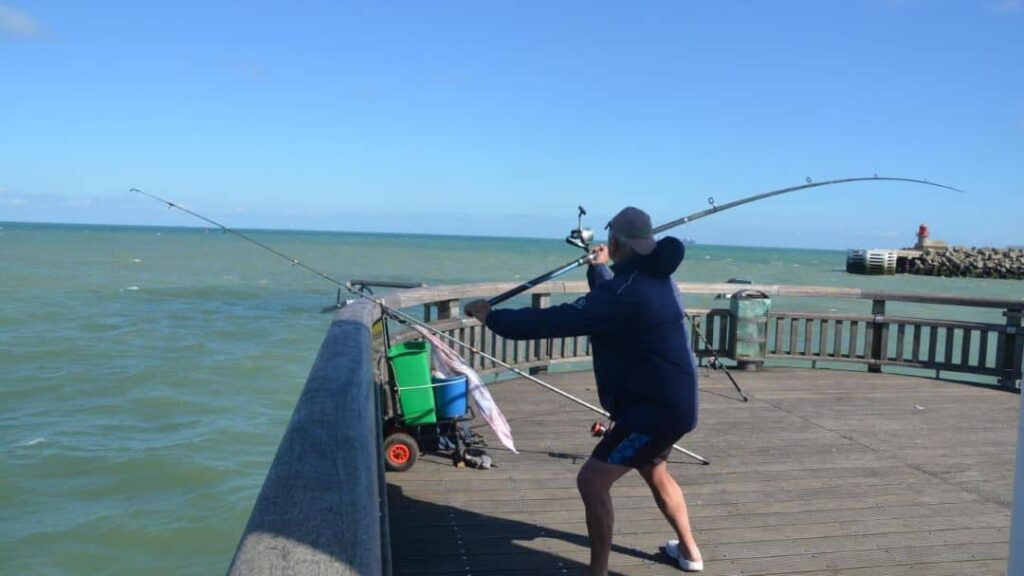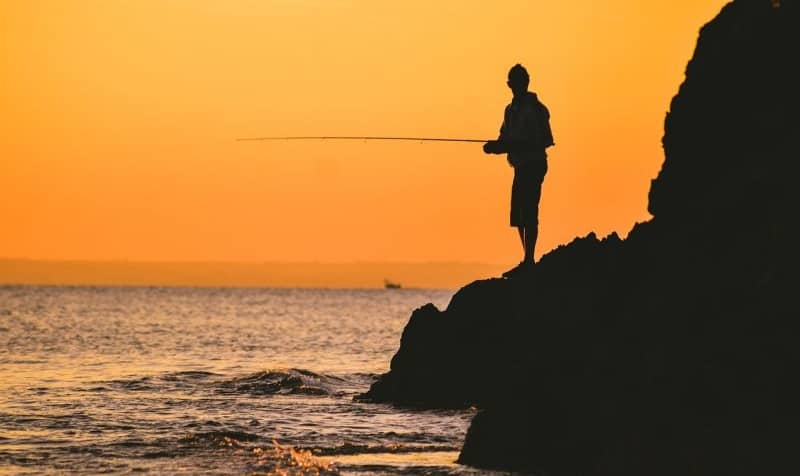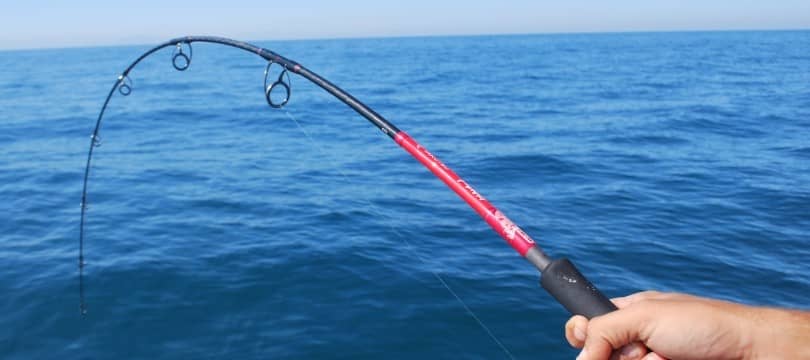The best sea fishing rod length depends on various factors, including the type of fishing you plan to do, the species you’re targeting, the fishing location, and your personal preferences. In general, sea fishing rods come in a range of lengths, and each length has its advantages and disadvantages.
Read on to discover some considerations for choosing the appropriate rod length.
Casting distance
Longer rods typically allow for longer casting distances, which can be advantageous when you need to reach fish that are further from the shore or boat.
Power and control
Shorter rods often provide more power and control, which is beneficial when you’re targeting larger, stronger fish that require more force to reel in.
Fighting fish
A longer beachcaster rod can give you a better leverage advantage when fighting against a powerful fish, making it easier to tire out and land the catch.
Portability
Shorter rods are generally more portable and easier to transport, which can be important if you need to move around frequently or have limited storage space.
Fishing conditions
Consider the sea conditions you’ll be facing. In rough seas, a shorter rod might be more manageable and less prone to bending excessively.
Ultimately, it’s essential to match the rod length to the specific type of fishing you’ll be doing and the species you’re targeting. If possible, try out different lengths to see what feels most comfortable and suitable for your fishing style. Additionally, consider the rod’s action, power, and material, as these factors also play a role in determining the best rod for your needs.
The Best Rod Length for Beach Fishing

Beach fishing is a popular and rewarding activity in the UK, attracting anglers seeking a diverse range of species and the thrill of fishing along the coastline. The choice of rod length for surf fishing is crucial, as it directly impacts the casting distance, ability to handle surf conditions, and the chance of hooking into larger, deeper-swimming fish.
Longer Casting Distance
Beach fishing often requires anglers to reach beyond the breaking waves and into deeper waters where fish like bass, cod, rays, and flatfish frequent. A longer rod provides the advantage of increased casting distance, allowing you to access these productive areas that may be otherwise unreachable with shorter rods. Rod lengths in the range of 10 to 14 feet (3 to 4.2 meters) are commonly favoured for beach fishing purposes.
Handling Surf Conditions
Fishing from the shoreline exposes anglers to surf conditions, including crashing waves and strong currents. Longer rods shine in such environments by elevating the line above the breaking waves, reducing the risk of it being dragged back to shore. This elevated position also helps prevent the line from getting entangled in seaweed or other debris, providing a smoother fishing experience.
Dealing with Tidal Changes
Beach fishing often takes place during tidal changes, where the water level fluctuates, affecting the distance from the shore to deeper waters. Longer rods offer versatility in handling these changes, allowing you to adjust your casting distance as needed to stay within the feeding zone of the fish.
Battling Larger Fish
When targeting larger species like rays or cod that dwell in deeper waters, a longer rod offers increased leverage during the fight. The added length allows you to apply more pressure on the fish, wearing it down more effectively before bringing it ashore.
Casting Efficiency
While longer rods are beneficial for reaching distant spots, they can also provide more efficient casting overall. The longer rod butt enables a longer casting stroke, which, when combined with proper technique, can result in smoother and more accurate casts.
Multiple Anglers
Surf fishing is often a social activity, and if you are fishing with friends or family, longer rods can be advantageous in giving everyone ample space to fish without their lines crossing and tangling.
In summary. For beach fishing in the UK, longer rods in the range of 10 to 14 feet (3 to 4.2 meters) are the preferred choice. They provide anglers with increased casting distance, better handling of surf conditions, versatility in dealing with tidal changes, and improved leverage when battling larger fish. By choosing the right rod length and pairing it with appropriate tackle and bait, beach anglers can increase their chances of a successful and enjoyable fishing experience along the captivating UK coastline.
The Best Spinning Fishing Rods Reviewed
Check out our reviews of the top 10 spinning rods.
The Best Rod Length for Pier Fishing

Pier fishing is a popular and rewarding activity in the UK, offering access to a diverse range of species and the opportunity to fish in deeper waters without the need for a boat. When it comes to selecting the best rod length for pier fishing, several key factors come into play, each influencing the overall success and enjoyment of the fishing experience.
Casting Distance
One of the primary considerations for pier fishing is casting distance. Piers often extend into deeper waters, and anglers need to cast their bait or lures far enough to reach where the fish are. A longer rod allows for more powerful and longer casts, providing access to fish that may be farther from the pier’s edge. In this regard, a rod length between 7 to 10 feet (2.1 to 3 meters) is commonly recommended for pier fishing.
Pier Height and Structure
The height and structure of the pier itself can influence the ideal rod length. Some piers have low railings or barriers that can obstruct longer casts with an extended rod. In such cases, a medium-length rod around 7 to 8 feet (2.1 to 2.4 meters) may be more practical, allowing anglers to cast effectively without worrying about obstructions.
Line Control and Sensitivity
Pier fishing often involves fishing in various water depths, and having good line control and sensitivity are crucial for detecting bites and setting the hook properly. A longer rod offers better line control, especially when using longer leaders to fish at different water levels. It allows anglers to manipulate the bait/lure and respond quickly to bites or changes in the water conditions.
Manoeuvrability
While casting distance and line control are essential, manoeuvrability is also a significant factor to consider. In crowded pier fishing scenarios, anglers need to navigate their rods around other anglers, railings, and fishing gear. A medium-length rod strikes a balance between casting distance and manoeuvrability, making it easier to handle and control in tight spaces.
Target Species
The species you’re targeting can influence the ideal rod length for pier fishing. For instance, if you’re after larger species that require more force to reel in, a longer rod provides better leverage and power during the fight. On the other hand, if you’re targeting smaller fish, a medium-length rod is more than sufficient and offers a more enjoyable fishing experience.
In summary. The best rod length for pier fishing in the UK depends on various factors, including the pier’s height and structure, the target species, and the angler’s preference for casting distance and manoeuvrability. A versatile choice is a medium-length rod between 7 to 8 feet (2.1 to 2.4 meters), as it offers a good compromise between casting distance, line control, and ease of use in crowded pier settings. However, if long-distance casting is a top priority, a longer rod between 8 to 10 feet (2.4 to 3 meters) may be the preferred option. Regardless of the chosen rod length, always ensure it’s matched with the appropriate reel, line, and tackle to maximise your chances of success while pier fishing in the UK.
The Best Rod Length for Rock Fishing

Rock fishing requires anglers to navigate challenging and rugged coastal terrains, often casting in close proximity to rocky structures and uneven surfaces. To optimise the fishing experience in such environments, the choice of rod length plays a crucial role. Here, we’ll delve into why shorter rods are the best option for rock fishing and explore their advantages in this specific fishing scenario.
Manoeuvrability and Control
One of the primary advantages of using a shorter rod, typically ranging from 6 to 9 feet (1.8 to 2.7 meters), is the improved manoeuvrability and control it provides in rocky areas. When fishing close to rocks, there is a higher risk of snagging the line on uneven surfaces during the cast or retrieve. A shorter rod minimises the chances of entanglement, allowing anglers to navigate tight spaces and cast with precision.
Casting in Limited Spaces
Rock fishing spots are often nestled between rocky outcrops or cliffs, leaving anglers with limited casting space. A shorter rod allows for more accurate casts in confined areas, which can be crucial when trying to reach productive fishing zones hidden among the rocks. This precision is especially valuable when targeting species that tend to congregate near rocky structures.
Better Line Control
When fishing around rocks, it’s essential to maintain better control over the fishing line, especially during the retrieve phase. Shorter rods provide anglers with enhanced control, enabling them to manipulate the lure or bait with greater accuracy and finesse. This control proves useful when trying to entice wary fish to strike or when navigating the bait through rocky crevices where fish may be hiding.
Enhanced Sensitivity
Shorter rods generally offer greater sensitivity due to their compact design. This heightened sensitivity allows anglers to detect subtle bites and changes in the underwater terrain. When fishing in rocky environments, being attuned to these subtle signals is essential for recognising when a fish has taken the bait, especially when the fishing line is in close proximity to rocky surfaces.
Reduced Fatigue
Rock fishing can be physically demanding, as anglers often need to traverse uneven and rough terrain to reach the fishing spots. Shorter rods are lighter and easier to handle, reducing the strain on the angler’s arm and shoulder during extended periods of casting and retrieval. This factor becomes increasingly significant when fishing sessions last for hours.
In summary. When it comes to rock fishing, shorter rods ranging from 6 to 9 feet (1.8 to 2.7 meters) offer significant advantages over their longer counterparts. The increased manoeuvrability, precise casting ability, better line control, enhanced sensitivity, and reduced fatigue make shorter rods the ideal choice for this rugged and challenging fishing environment. With the right equipment in hand, anglers can fully immerse themselves in the thrill of rock fishing, knowing they have the tools to handle the intricacies and obstacles of this unique fishing adventure.
The Best Rod Length for Boat Fishing

Boat fishing in the UK’s coastal waters is a popular and rewarding experience, offering anglers the opportunity to catch a wide variety of species. When it comes to selecting the best rod length for boat fishing, several important factors should be considered to ensure an enjoyable and successful fishing trip.
Casting Distance and Accuracy
The ideal rod length for boat fishing should allow anglers to cast their baits or lures effectively and accurately. In most boat fishing scenarios, you’re not casting long distances like you would on the beach. Instead, you need to cast to specific spots around the boat, such as drop-offs, wrecks, or reefs where fish are likely to congregate. A rod with a length between 7 to 9 feet (2.1 to 2.7 meters) strikes a good balance, providing sufficient casting distance without being overly long and cumbersome.
Line Control and Fighting Ability
When fishing from a boat, you may encounter various species of fish, including powerful fighters like cod, pollock, and conger eels. A medium-length rod offers the advantage of better line control during the retrieve, allowing you to guide the fish away from potential snags or other obstacles around the boat. It also provides the necessary power to handle these hard-fighting species, making it easier to tire them out and bring them aboard.
Manoeuvrability
Boat fishing often requires anglers to move around the boat to follow fish or adjust to changing conditions. A rod with a length of 7 to 9 feet offers excellent manoeuvrability, making it easier to navigate around the boat without getting tangled in other lines or obstructed by the vessel’s structure.
Sensitivity
The sensitivity of the rod is crucial for detecting subtle bites and distinguishing between different types of bottom structures. A medium-length rod typically provides a good balance of sensitivity, allowing you to feel the smallest nibbles while still having enough power to handle larger fish effectively.
Versatility
A medium-length rod for boat fishing is also versatile enough to handle various fishing techniques, such as jigging, bottom fishing, and trolling. This adaptability makes it a reliable choice for different fishing situations and species, reducing the need to carry multiple rods on the boat.
In summary. For boat fishing in the UK, a rod length of 7 to 9 feet (2.1 to 2.7 meters) is generally considered the best option. It provides the right balance of casting distance, line control, fighting ability, and manoeuvrability, making it suitable for various fishing techniques and different species. However, keep in mind that personal preferences and fishing conditions may influence your choice, so it’s essential to try out different rod lengths and find the one that best suits your specific style of boat fishing. Remember, investing in a quality rod will enhance your overall fishing experience and increase your chances of landing that prized catch during your UK boat fishing adventures.
The Best Boat Fishing Rods Reviewed
Check out our reviews of the top 10 boat rods.
The Best Rod Length for General Fishing
When it comes to general fishing, anglers often seek a versatile rod that can perform well in various fishing environments and target a wide range of species. The best rod length for general fishing typically falls in the range of 9 to 10 feet (2.7 to 3 meters). Let’s explore why this length is considered ideal for general fishing:
Casting Distance
A rod in the 9 to 10 feet range offers a good compromise between casting distance and manageability. While it may not cast as far as longer beach fishing rods, it still provides sufficient reach to cover a decent distance from shore or a boat, allowing anglers to explore various fishing spots effectively.
Flexibility in Fishing Environments
General fishing encompasses a variety of settings, including beach, pier, and boat fishing. A rod around 9 to 10 feet in length is versatile enough to handle these different environments, giving anglers the flexibility to fish from multiple locations without needing specific rods for each.
Control and Sensitivity
In general fishing, having control over the line and being able to detect subtle bites or movements is crucial. A rod in this length range offers a good balance of sensitivity and power, allowing anglers to feel the slightest nibbles while maintaining the strength to handle larger fish.
Versatility in Target Species
A medium-length rod is suitable for targeting a wide range of species commonly found in the UK’s coastal waters, such as bass, mackerel, pollack, cod, and more. Whether you’re using bait, lures, or even light tackle, this length provides the versatility needed to catch various fish species effectively.
Portability
A rod in the 9 to 10 feet range is still relatively portable, making it easier to transport compared to longer rods commonly used for specialised fishing, like surf or boat fishing. This portability is especially beneficial if you need to move between different fishing spots or if storage space is limited.
Comfortable Handling
Fishing with a rod that feels comfortable in your hands is essential for a pleasant fishing experience. A medium-length rod is generally more manageable for most anglers, reducing fatigue during long fishing sessions and making it easier to cast and control the line.
In summary. For anglers seeking a versatile option that can perform well in a variety of fishing environments and target a wide range of species, a medium-length rod around 9 to 10 feet proves to be an excellent choice for general fishing in the UK. Its balanced combination of casting distance, control, sensitivity, and portability makes it a reliable tool for enjoying different fishing experiences along the UK’s coastline. Whether you’re fishing from the beach, pier, or boat, or trying to catch various species, a medium-length rod will serve you well and enhance your enjoyment of the sea fishing adventures.
Conclusion
Choosing the right sea fishing rod length is crucial for success in various UK fishing environments. For beach fishing, opt for longer rods to reach deeper waters and access larger fish. Pier fishing calls for medium-length rods to strike a balance between casting distance and control. In rocky areas, shorter rods offer better manoeuvrability and reduce the risk of snagging. Boat fishing benefits from rods with a moderate length, allowing for efficient casting and control. For anglers seeking a versatile option, a medium-length rod around 9 feet proves to be an excellent all-around choice. Always consider the specific fishing conditions, target species, and your personal preferences when selecting the ideal sea fishing rod length for your UK fishing adventures.
